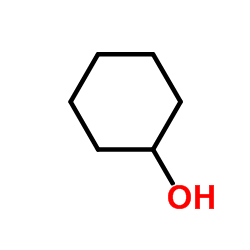Cyclohexanol

Cyclohexanol structure
|
Common Name | Cyclohexanol | ||
|---|---|---|---|---|
| CAS Number | 108-93-0 | Molecular Weight | 100.159 | |
| Density | 1.0±0.1 g/cm3 | Boiling Point | 159.6±8.0 °C at 760 mmHg | |
| Molecular Formula | C6H12O | Melting Point | 23ºC | |
| MSDS | Chinese USA | Flash Point | 67.8±0.0 °C | |
| Symbol |

GHS07 |
Signal Word | Warning | |
|
Acetonitrile adduct formation as a sensitive means for simple alcohol detection by LC-MS.
J. Am. Soc. Mass Spectrom. 25(11) , 1987-90, (2014) Simple alcohols formed protonated acetonitrile adducts containing up to two acetonitrile molecules when analyzed by ESI or APCI in the presence of acetonitrile in the solvent. These acetonitrile adducts underwent dissociation to form a nitrilium ion, also ref... |
|
|
Lignin Modification for Biopolymer/Conjugated Polymer Hybrids as Renewable Energy Storage Materials.
ChemSusChem 8 , 4081-5, (2015) Lignin derivatives, which arise as waste products from the pulp and paper industry and are mainly used for heating, can be used as charge storage materials. The charge storage function is a result of the quinone groups formed in the lignin derivative. Herein,... |
|
|
The EpiOcular Eye Irritation Test (EIT) for hazard identification and labelling of eye irritating chemicals: protocol optimisation for solid materials and the results after extended shipment.
Altern. Lab. Anim. 43 , 101-27, (2015) The 7th Amendment to the EU Cosmetics Directive and the EU REACH Regulation have reinforced the need for in vitro ocular test methods. Validated in vitro ocular toxicity tests that can predict the human response to chemicals, cosmetics and other consumer prod... |
|
|
Convenient QSAR model for predicting the complexation of structurally diverse compounds with β-cyclodextrins
Bioorg. Med. Chem. 17 , 896-904, (2009) This paper reports a QSAR study for predicting the complexation of a large and heterogeneous variety of substances (233 organic compounds) with beta-cyclodextrins (beta-CDs). Several different theoretical molecular descriptors, calculated solely from the mole... |
|
|
Efficient and simple approaches towards direct oxidative esterification of alcohols.
Chemistry 20(47) , 15618-24, (2014) The present article describes novel oxidative protocols for direct esterification of alcohols. The protocols involve successful demonstrations of both "cross" and "self" esterification of a wide variety of alcohols. The cross-esterification proceeds under a s... |
|
|
Poly(N-vinylimidazole/ethylene glycol dimethacrylate) for the purification and isolation of phenolic acids.
Anal. Chim. Acta 885 , 199-206, (2015) In this study we report the novel polymeric resin poly(N-vinyl imidazole/ethylene glycol dimethacrylate) for the purification and isolation of phenolic acids. The monomer to crosslinker ratio and the porogen composition were optimized for isolating phenolic a... |
|
|
Robust naphthyl methacrylate monolithic column for high performance liquid chromatography of a wide range of solutes.
J. Chromatogr. A. 1409 , 166-72, (2015) An organic monolithic column based on the co-polymerization of 2-naphthyl methacrylate (NAPM) as the functional monomer and trimethylolpropane trimethacrylate (TRIM) as the crosslinker was introduced for high performance reversed-phase liquid chromatography (... |
|
|
On chip preconcentration and fluorescence labeling of model proteins by use of monolithic columns: device fabrication, optimization, and automation.
Anal. Bioanal. Chem 407(3) , 737-47, (2015) Microfluidic systems with monolithic columns have been developed for preconcentration and on-chip labeling of model proteins. Monoliths were prepared in microchannels by photopolymerization, and their properties were optimized by varying the composition and c... |
|
|
Characterization of ceramic hydroxyapatite surface by inverse liquid chromatography in aquatic systems.
Talanta 147 , 44-9, (2015) The novel approach for hydroxyapatite (HA) surface characterization was proposed. The main aim of this investigation was to estimate surface properties of HA as a biomaterial in real system i.e. in simulated body fluid (SBF). One of the method, which might be... |
|
|
A closer study of peak distortions in supercritical fluid chromatography as generated by the injection.
J. Chromatogr. A. 1400 , 131-9, (2015) In SFC the sample cannot be dissolved in the mobile phase, so it is often dissolved in pure modifier, or another liquid, sometimes resulting in serious distortions of the eluted peak profiles already at moderately high injection volumes. It is suspected the r... |